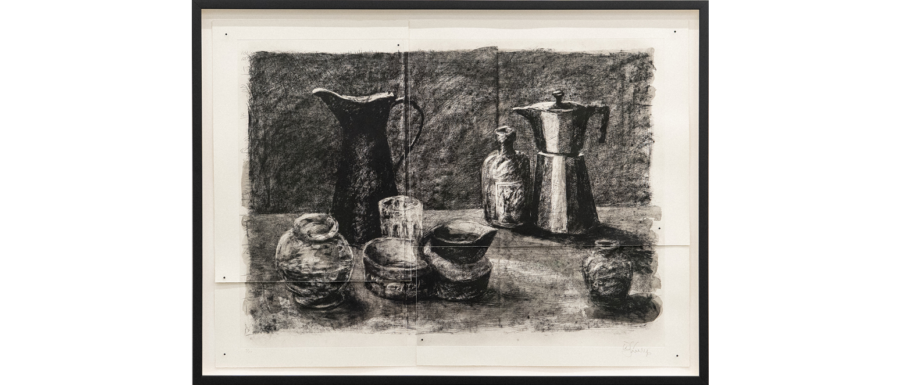Eight Vessels
In the first film in Kentridge’s nine-part series, Self-Portrait as a Coffee Pot, which offer a cinematic experience of the life of the studio, an image containing an arrangement of vessels appears a number of times. These everyday objects refer to a time in which Kentridge was in the curious position of being alone in his studio for the first time in many years. Subsequently, he began experimenting with drawing the objects he had at hand – jugs, jars, coffee pots, glasses, vases, an ink tin, a whiskey bottle – as a way to make sense of what felt like a sense-evading experience: a global pandemic that forced most people into isolation for extended periods, and caused major disruption to both public/political and personal landscapes.
Eight Vessels, published by Jillian Ross Print, was developed alongside the series of Studio Life gravures, published by David Krut Workshop, and the series of films that Kentridge was pursing at the same time, as a way to navigate the sudden enforced distance between himself and his team of collaborators. This image offered an opportunity for Kentridge to continue collaborating with Ross, despite the magnitude of the distance suddenly between them, with Ross having relocated with her family to her home country of Canada at the onset of lockdown in South Africa, which she had called home for close to two decades. As an image, Eight Vessels is the culmination of various investigations of objects arranged in a composition, not for the significance of the objects themselves, but rather for what can be gained from drawing the same (or similar) compositions over and again. The process suggests that these simple, anonymous and universal objects can suggest something lyrical, as if sustained contemplation might strip these objects to their essence, underscoring the transcendent worth of ordinary, everyday beauty.
Eight Vessels, made up of four sheets printed, hand-painted and overlapped to form a single image, has been conceptualised in the way of Italian painter and printmaker Giorgio Morandi’s iconic still life works. Morandi’s work, typically featuring quotidian objects analogous to those depicted in Eight Vessels, was fundamentally informed by his sense that “to achieve understanding it is necessary not to see many things, but to look hard at what you do see.” This sentiment is particularly relevant to the time in which Eight Vessels was created, when Kentridge’s experience – and that of most other people in the world – was suddenly limited to what existed in his immediate vicinity, in his own home, the refuge offered by the meaning-making realm of the studio, and the challenge of finding new ways to work, and to make work.
| Artist: | William Kentridge |
| Title: | Eight Vessels |
| More about: | William Kentridge |
| Year: | 2021 |
| Artwork Category:: | Editions & Multiples from Other Publishers |
| Media & Techniques: | 4-plate photogravure with hand painting on 4 sheets of overlapping Hahnemühle Natural White 300gsm. |
| Printer: | Jillian Ross |
| Edition Size: | 20 |
| Sheet Height: | 73 cm |
| Sheet Width: | 99.6 cm |
| Availability: | Available |
| Framing: | Unframed |
